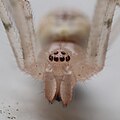
Theridiidae, also known as the tangle-web spiders, cobweb spiders and comb-footed spiders, is a large family of araneomorph spiders first described by Carl Jakob Sundevall in 1833. This diverse, globally distributed family includes over 3,000 species in 124 genera, and is the most common arthropod found in human dwellings throughout the world.

Scaffold web spiders or cave cobweb spiders (Nesticidae) are a family of araneomorph spiders closely allied with tangle-web spiders (Theridiidae). Like the Theridiidae, these spiders have a comb of serrated bristles on the hind tarsi that are used to pull silk bands from the spinnerets. Nesticidae contains 16 genera and about 300 species, many of which are associated with caves or overhangs. The genus Nesticus is the type for the family and is found throughout the world. The related Eidmannella has speciated considerably in Texas caves and includes some extremely localized species that are considered threatened. One species, Eidmannella pallida, is found in caves and under overhangs, but also in agricultural fields and other habitats away from such restricted areas. The genus Carpathonesticus is found in central Eurasia.

Achaearanea is a genus of comb-footed spiders that was first described by Embrik Strand in 1929.

The katipō is an endangered species of spider native to New Zealand. It is one of many species in the genus Latrodectus, such as the Australian redback, and the North American black widow. The species is venomous to humans, capable of delivering a potentially dangerous bite. It is a small to medium-sized spider, with the female having a round black or brown pea-sized body. Red katipō females found in the South Island and the lower half of the North Island, are always black, and their abdomen has a distinctive red stripe bordered in white. In black katipō females found in the upper half of the North Island, this stripe is absent, pale, yellow, or replaced with cream-coloured blotches. These two forms were previously thought to be separate species. The male is much smaller than the female and quite different in appearance: white with black stripes and red diamond-shaped markings. Katipō are mainly found living in sand dunes close to the seashore. They are found throughout most of coastal New Zealand except the far south and west. Katipō feed mainly on ground dwelling insects, caught in an irregular tangled web spun amongst dune plants or other debris.

Theridiosoma is a genus of ray spiders that was first described by Octavius Pickard-Cambridge in 1879. They use their web as a high speed slingshot to actively hunt for prey.

The spider genus Steatoda, in the family Theridiidae, includes about 120 recognized species, distributed around the world. One common name is cupboard spider, for many species build their webs in dark, sheltered, undisturbed places around the house or garden, in sheds and garages, under garden, compost bins, and the like. Signs of the cupboard spider include small white spots of spider droppings, like small splashes of paint, on the floor underneath the web.

Argyrodes, also called dewdrop spiders, is a genus of comb-footed spiders that was first described by Eugène Louis Simon in 1864. They occur worldwide, and are best known for their kleptoparasitism. They can spin their own webs, but tend to invade and reside in their hosts' webs. This relationship can be commensal or even mutual if the dewdrop spider feeds on small trapped insects that are not eaten by the host. Some species can even prey upon the host.

Wirada is a genus of comb-footed spiders that was first described by Eugen von Keyserling in 1886.
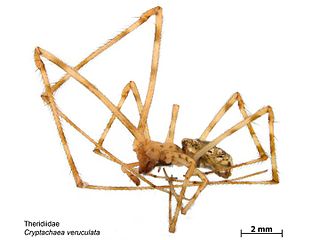
Cryptachaea veruculata is a spider native to Australia and New Zealand. It has been introduced into England and Belgium. The species has potential to control spider mites and leafroller caterpillars in New Zealand.

Anelosimus is a cosmopolitan genus of cobweb spiders (Theridiidae), currently containing 74 species. Anelosimus is a key group in the study of sociality and its evolution in spiders. It contains species spanning the spectrum from solitary to highly social (quasisocial), with eight quasisocial species, far more than any other spider genus. Among these is the South American social species Anelosimus eximius, among the best studied social spider species.

Steatoda capensis is a spider originating from South Africa. Its common names include the black cobweb spider, brown house spider, cupboard spider and due to its similarities to the katipō spider it is commonly known as the false katipō in New Zealand. Common throughout Southern Africa, it has been introduced into other countries and is now present in Australia and throughout New Zealand. It is a small spider, usually an all-over shiny black. It may have a small bright red, orange, or yellow patch near the tip of the abdomen along with a crescent shaped band near the front of the abdomen.

Cryptachaea is a genus of spiders in the Theridiidae family.

Parasteatoda is a genus of comb-footed spiders that was first described by Allan Frost Archer in 1946. The name is a combination of the Ancient Greek "para-" (παρά), meaning "near" or "next to", and the theridiid genus Steatoda. The Japanese name for this genus is O-himegumo zoku.
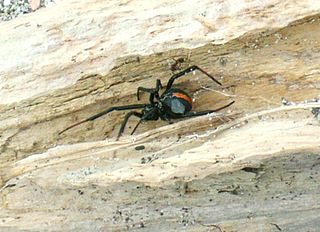
New Zealand has 1157 described spider species, with an estimated total fauna of 2000 species. Over 97 per cent are endemic, and the rest have been introduced through human activities or were natural wind-borne introductions.

Ariamnes is a genus of comb-footed spiders that was first described by Tamerlan Thorell in 1869. Some species have greatly elongated abdomens, making them resemble a twig.
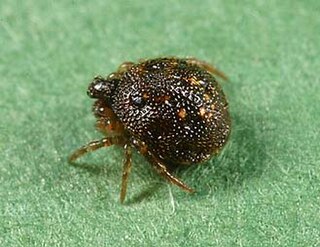
Phoroncidia is a genus of comb-footed spiders that was first described by J. O. Westwood in 1835.

Neospintharus is a genus of comb-footed spiders that was first described by H. Exline in 1950. It was synonymized with Argyrodes in 1962, but revalidated in 2004.

Phycosoma is a genus of comb-footed spiders that was first described by Octavius Pickard-Cambridge in 1880.
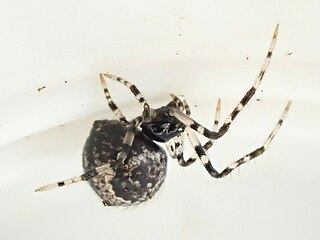
Cryptachaea blattea is a species of cobweb spider in the family Theridiidae. It is found in Africa, and has been introduced into the United States, Chile, the Azores, Europe, Australia, New Zealand, and Hawaii.
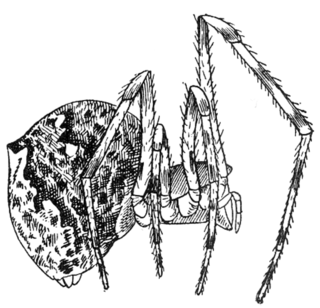
Cryptachaea rupicola is a species of cobweb spider in the family Theridiidae. It is found in the United States and Canada.

